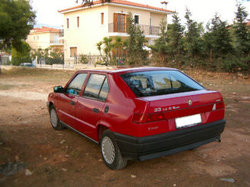Difference between revisions of "Alfa Romeo 33"
m |
m |
||
| Line 82: | Line 82: | ||
| − | {| | + | {| border=1 cellspacing=3 cellpadding=4 style="float:center; margin:0 0 .5em 1em; width:250px; background:#505050; border-collapse:collapse; border:1px solid #999; font-size:83%; line-height:1.5; " summary="Infobox Automobile" |
| + | |- style="text-align:center; background:#505050;" | ||
| + | |- tr BGCOLOR=darkred | ||
|td width="30%" align="center"|'''Preceded by''':<br>''No preceding model'' | |td width="30%" align="center"|'''Preceded by''':<br>''No preceding model'' | ||
|td width="30%" align="center"|'''Succeeded by''':<br>[[Alfa Romeo Arna]]<br>[[Alfa Romeo 33]] | |td width="30%" align="center"|'''Succeeded by''':<br>[[Alfa Romeo Arna]]<br>[[Alfa Romeo 33]] | ||
Revision as of 22:19, 18 February 2009
| Alfa Romeo 33 | |
| Alfa Romeo 33 | |
|---|---|
| Manufacturer: | Alfa Romeo |
| Production: | 1983-1994 |
| Body Styles: | FF compact 5-door hatchback & station wagon |
| Predecessors: | Alfa Romeo Alfasud |
| Successors: | Alfa Romeo 145/146 |
| Competitors: | Ford Escort Volkswagen Golf |
| Alfa Romeo 33 | |
The Alfa Romeo 33 was a compact car built between by Alfa Romeo between 1983 and 1994.
The Alfa Romeo 33 is a small family car producerd by the Italian automaker Alfa Romeo between 1983 and 1994. It was essentially an evolution of its predecessor, the Alfasud, which was based on the same floorplan, chassis and mechanicals albeit with some minor modifications. The 33 was discontinued in 1994 and replaced by the Alfa Romeo 145 and 146, which used the same Boxer engines but built around an entirely new platform based on the Fiat Tipo.
Overview
The 5-door hatchback version was launched in 1983, and a station wagon version (initially badged Giardinetta, later badged SportWagon) was introduced the following year as the same time as a four-wheel drive version of the hatchback. The hatchback was styled by the Centro Stile Alfa Romeo, Ermano Cressoni, while the station wagon was designed by Pininfarina.
The 33 became renowned for its nimble handling and powerful boxer engines, but also became equally well-known for its unreliable electrics and tendencies to rust (a frequent complaint on Italian cars in general at the time).
The 33 has a unique place in Alfa Romeo history - Nearly 1 million of these cars were produced internationally, and it is probably the most common Alfa Romeos to be found on the roads.
Facelifts
During its 11 year lifespan the 33 saw two restyles; In consequence Alfisti tend to label each styling trend of the 33 after the flagship vehicle produced by Alfa Romeo at that time.
The First 33's are sometimes referred to as 'Alfa 90' 33s, as they most resemble that car. Further re-styles were to follow: a mild one in autumn 1986, when the 1.7 litre engine was introduced and a revised interior; these are known as 'Alfa 75' 33s. Later followed a much more extensive facelift in the end of 1989 (the Series III), with a revised interior, the introduction of fuel injection, the 1.7 litre engine upgraded to include a 137 bhp 16 valve version, and a heavily restyled exterior, in line with the new Alfa "family look" established by the flagship 164. Also new four wheel version was introduced called as Permanent 4, which was renamed to Q4 starting from 1992. The last 33s are known as either 'Nuova' or '164' 33s for their resemblance to that model.
These models are particularly prized by Alfisti for their performance and sophistication. Late production 33s also do not suffer from the rust problems of their ancestors, as their frames are galvanized in the manner Alfa introduced with the 164.
Engines
Single carburettor engines
- 1.2, Boxer - 68 bhp
- 1.3, Boxer - 79 bhp
- 1.5, Boxer - 85 bhp
Twin carburettor engines
- 1.3 Boxer twin weber IDF 32 or Dell Orto DRLA 32 86 hp
- 1.5 Boxer twin weber IDF 40 or Dell Orto DRLA 40 105 hp
- 1.7 Boxer twin weber IDF 40 or Dell Orto DRLA40 117 hp
Fuel injection engines
- 1.4 Boxer, 88 bhp (some markets under 1.3 logo)
- 1.5 Boxer, 97 bhp
- 1.7 Boxer 8v, 110 bhp (IE) (no catalizer)
- 1.7 16v Boxer, 137 - 132 bhp (QV)
- 1.8 TD 83 hp (3 Cyl)
1999 Alfa Romeo 33 1.7L 16V Turbo Race Car
- 1999 Alfa Romeo 33 1.7L 16V Turbo Race Car 1.jpg
- 1999 Alfa Romeo 33 1.7L 16V Turbo Race Car 2.jpg
- 1999 Alfa Romeo 33 1.7L 16V Turbo Race Car 3.jpg
- 1999 Alfa Romeo 33 1.7L 16V Turbo Race Car 4.jpg
- 1999 Alfa Romeo 33 1.7L 16V Turbo Race Car 5.jpg
- 1999 Alfa Romeo 33 1.7L 16V Turbo Race Car 6.jpg
- 1999 Alfa Romeo 33 1.7L 16V Turbo Race Car 8.jpg
- 1999 Alfa Romeo 33 1.7L 16V Turbo Race Car 9.jpg
- 1999 Alfa Romeo 33 1.7L 16V Turbo Race Car 10.jpg
- 1999 Alfa Romeo 33 1.7L 16V Turbo Race Car 12.jpg
External links
- Alfa Website also with Racing with History
- 1968 Race results
- 1972 Racing season Alfa vs. Ferrari
- Dutch alfaclub with lots of technical information
| Preceded by: No preceding model |
Succeeded by: Alfa Romeo Arna Alfa Romeo 33 |
